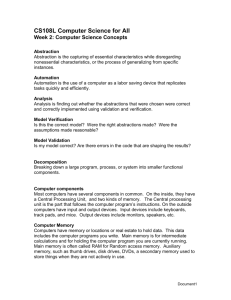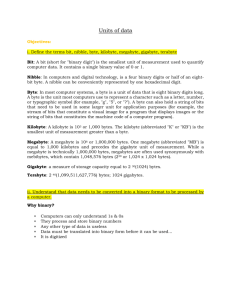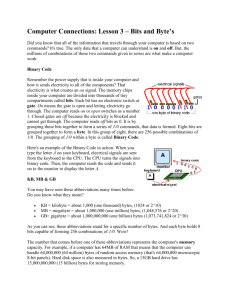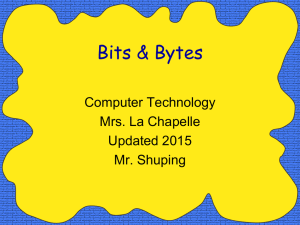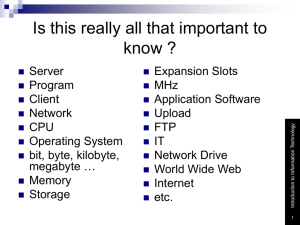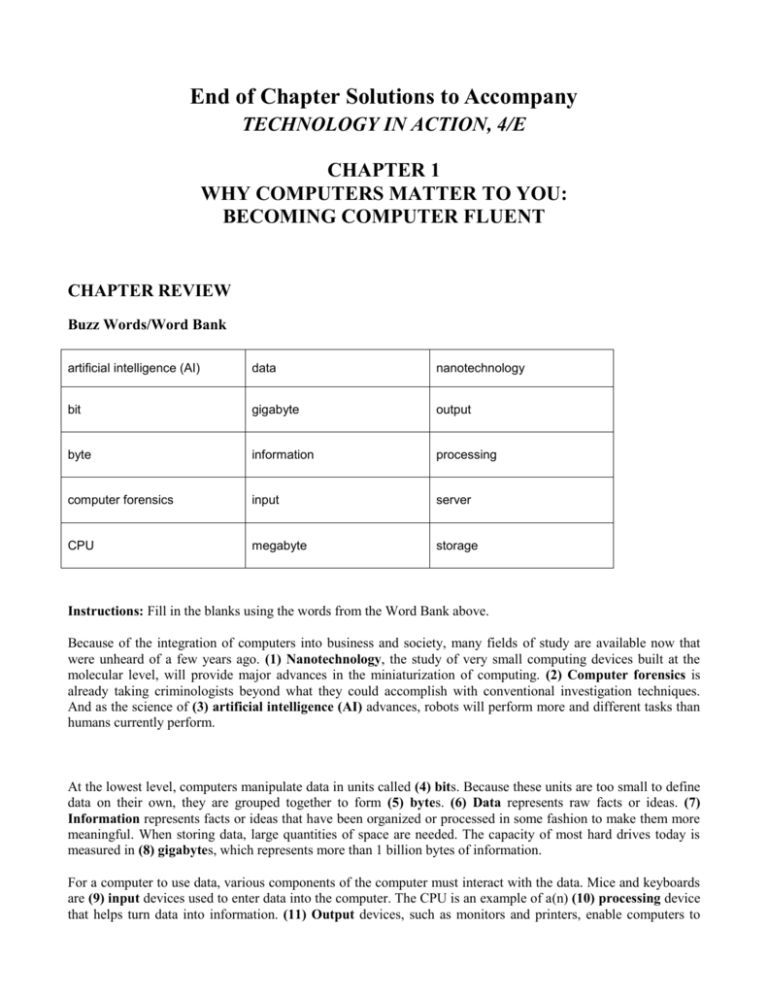
End of Chapter Solutions to Accompany
TECHNOLOGY IN ACTION, 4/E
CHAPTER 1
WHY COMPUTERS MATTER TO YOU:
BECOMING COMPUTER FLUENT
CHAPTER REVIEW
Buzz Words/Word Bank
artificial intelligence (AI)
data
nanotechnology
bit
gigabyte
output
byte
information
processing
computer forensics
input
server
CPU
megabyte
storage
Instructions: Fill in the blanks using the words from the Word Bank above.
Because of the integration of computers into business and society, many fields of study are available now that
were unheard of a few years ago. (1) Nanotechnology, the study of very small computing devices built at the
molecular level, will provide major advances in the miniaturization of computing. (2) Computer forensics is
already taking criminologists beyond what they could accomplish with conventional investigation techniques.
And as the science of (3) artificial intelligence (AI) advances, robots will perform more and different tasks than
humans currently perform.
At the lowest level, computers manipulate data in units called (4) bits. Because these units are too small to define
data on their own, they are grouped together to form (5) bytes. (6) Data represents raw facts or ideas. (7)
Information represents facts or ideas that have been organized or processed in some fashion to make them more
meaningful. When storing data, large quantities of space are needed. The capacity of most hard drives today is
measured in (8) gigabytes, which represents more than 1 billion bytes of information.
For a computer to use data, various components of the computer must interact with the data. Mice and keyboards
are (9) input devices used to enter data into the computer. The CPU is an example of a(n) (10) processing device
that helps turn data into information. (11) Output devices, such as monitors and printers, enable computers to
Chapter 1: Why Computers Matter to You: Becoming Computer Fluent
provide information in a usable format. To save information and data for later use, (12) storage devices such as
hard disk drives are used.
Self-Test
Instructions: Answer the multiple choice and true/false questions below for more practice with key terms and
concepts from this chapter.
MULTIPLE CHOICE
1. Which of the following is not one of the four major functions of a computer?
a. input
b. storage
c. enumeration
d. processing
ANSWER: C
2. Data becomes information when:
a. it is entered into a computer.
b. a computer performs calculations with the data.
c. the data is organized in a specific manner.
d. the data is output to a computer screen or printer.
ANSWER: C
3. In the binary language, each 0 or 1 is referred to as a:
a. byte.
b. bit.
c. kilobyte.
d. nanobyte.
ANSWER: B
4. Eight bits combine to create:
a. one megabyte.
b. one kilobyte.
c. one bit.
d. one byte.
ANSWER: D
5. A kilobyte is approximately:
a. 100 bytes.
b. 1,000 bytes.
c. one million bytes.
d. one billion bytes.
ANSWER: B
Copyright © 2008 Prentice-Hall. All rights reserved.
2
Chapter 1: Why Computers Matter to You: Becoming Computer Fluent
6. A megabyte is approximately:
a. 100 bytes.
b. 1,000 bytes.
c. one million bytes.
d. one billion bytes.
ANSWER: C
7. Which of the following is not an input device?
a. keyboard
b. mouse
c. digital camera
d. CD-ROM drive
ANSWER: D
8. Which of these is not an output device?
a. printer
b. floppy disk drive
c. monitor
d. speakers
ANSWER: B
9. Which of these is not a storage device?
a. hard disk drive
b. floppy disk drive
c. boot drive
d. CD drive
ANSWER: C
10. Spreadsheet programs (such as Excel) are an example of:
a. application software.
b. operating system software.
c. data mining software.
d. utility software.
ANSWER: A
TRUE/FALSE
False 1. The four major functions that a computer performs are input, output, storage, and dissemination.
True
2. Computers use a binary language composed of 0s and 1s to perform all calculations and functions.
False
3. Microsoft Windows is the most popular piece of application software sold today.
False
4. The CPU is located on RAM.
True
5. PCs and Macs are the two most common types of computer platforms.
Copyright © 2008 Prentice-Hall. All rights reserved.
3
Chapter 1: Why Computers Matter to You: Becoming Computer Fluent
Critical Thinking Questions
1. Rating Your Computer Fluency
This chapter lists a number of ways in which knowing about computers (or becoming computer fluent) will help
you. How much do you know about computers? What else would you like to know? How do you think learning
more about computers will help you in the future?
It might be interesting at this stage of the course to create a survey to find out what the students’ skill sets and
interests are. Their skills and interests will likely vary widely, and it is beneficial to know that in advance. Use
this information to lead a discussion that addresses how the course will fit in with their existing knowledge, and
proceed to build on that.
2. Data Mining
This chapter briefly discusses data mining, a technique companies use to study sales data and gather information
from it. Have you heard of data mining before? How might a company like Wal-Mart or Target use data mining to
better run their business? Can you think of any privacy risks data mining might pose?
Some students may have heard the term mentioned in the media or on the Web. One possibility is that companies
may gather information about your shopping habits, preferences, and so on, and sell it without your consent to
others along with your personal information. This could generate many unwanted solicitations.
3. Nanotechnology
As you learned in the chapter, nanotechnology is the science revolving around the use of nanostructures to build
devices on an extremely small scale. What applications of tiny computers can you think of? How might
nanotechnology impact your life?
Medical advancements using nanotechnology will likely be suggested here. Another possibility is portability of
high-powered computing resources. What if you could make a hand-held device behave exactly as your desktop
computer at home does?
4. Biomedical Chips
This chapter discusses various uses of biomedical chips. Many biomedical chip implants that will be developed in
the future will most likely be aimed at correcting vision loss, hearing loss, or other physical impediments. But
chips could also be developed to improve physical or mental capabilities of healthy individuals. For example,
chips could be implanted in athletes to make their muscles work better together, thereby allowing them to run
faster. Or, your memory could be enhanced by providing additional storage capacity for your brain.
a. Should biomedical implant devices that increase athletic performance be permitted in the Olympics?
b. What about devices that repair a problem (such as blindness in one eye) but then increase the level of visual
acuity in the affected eye so that it is better than normal vision?
c. Would you be willing to have a chip implanted in your brain to improve your memory?
d. Would you be willing to have a VeriChip implanted under your skin?
These questions should spark a lively debate, and answers may vary wildly. Steroid use by athletes has been an
issue for some time now. Ask students about the similarities or differences between the use of steroids and
implanted chips in sports. Ask them if they have ever seen A Beautiful Mind with Russell Crowe. In one scene,
Crowe’s character is desperately trying to remove what he thinks is an implanted chip from his arm so that his
enemies cannot locate him. Discuss how this type of technology could be both a blessing and a curse.
5. Artificial Intelligence
Copyright © 2008 Prentice-Hall. All rights reserved.
4
Chapter 1: Why Computers Matter to You: Becoming Computer Fluent
Artificial intelligence is the science that attempts to produce machines that display the same type of intelligence
that humans do. Do you think humans will ever create a machine that can think? In your opinion, what are the
ethical and moral implications associated with artificial intelligence?
Many students may have seen the movie AI, in which a boy is created to replace the ill son of a desperate couple.
The boy takes on lifelike qualities and learns to give and receive love. Is this really learned behavior or a feat of
programming? Has he become a “real boy”? This is hardly Pinocchio, and the moral implications are
frightening. Try to discuss them with your group.
Team Time
Promoting Future Technologies
This exercise gives students a chance to meet each other and talk informally about technology. The following
rubric may be useful for grading purposes.
Rubric
Beginning
Developing
Proficient
Exemplary
1 point
2 points
3 points
4 points
There was
Clear learning on
evidence of
the topic has
effort but it
occurred.
lacked in
preparation and
understanding.
A sound
understanding
of the topic
was exhibited
with
enthusiasm
and creativity.
Team Effort Team members did
not function as a
group when given
the opportunity.
There was only
individual work
with no evidence of
collaboration.
Team members
had some major
problems
working as a
group. There
was little
collaboration
and teamwork
evident.
The team
members mostly
worked well
together, with
few problems.
There could have
been
improvement in
the level of
teamwork that
was utilized.
The team
worked as a
cohesive unit.
There was
mature
collaboration,
compromise,
and discussion
evident at all
times.
The final
presentation had
major factual,
grammatical,
spelling, and
formatting errors. It
seemed rushed and
incomplete.
The final
presentation had
factual,
grammatical,
spelling, or
formatting
errors but was
complete.
The final
presentation was
a carefully
developed
product with few
factual,
grammatical,
spelling, or
formatting
errors.
The
presentation
was developed
with care and
creativity
making it
interesting,
polished, and
error-free.
Individual
Effort
Final
Product
There was very
little effort or
understanding of
the topic shown.
Copyright © 2008 Prentice-Hall. All rights reserved.
5
Score
Chapter 1: Why Computers Matter to You: Becoming Computer Fluent
Rubric
Beginning
Developing
Proficient
Exemplary
1 point
2 points
3 points
4 points
Feedback was
received and
some
suggestions were
incorporated into
the presentation.
Feedback was
received and
the
suggestions
were
incorporated
into the
presentation.
Instructor
Feedback
Little or no attempt
was made to
receive or
incorporate
feedback from the
instructor.
Evaluation
0 points
Feedback was
received, but
none of the
suggestions
were
incorporated
into the
presentation.
1 point
Score
2 points
No assessments were One assessment was
All assessments were
completed and
completed and handed in completed and handed
handed in to the
to the instructor.
in to the instructor.
instructor.
Multimedia
In addition to the review materials presented here, you’ll find additional materials featured with the book’s
multimedia, including the Technology in Action Student Resource CD and the Companion Web site
(www.prenhall.com/techinaction), which will help reinforce student understanding of the chapter content. These
materials include the following:
ACTIVE HELPDESK
These exercises are designed to provide the student with an interactive experience that will help them to extend
their knowledge of topics in this chapter. The student plays the “role” of a Helpdesk analyst and provides answers
to commonly asked questions in a rich, simulated online experience. Helpdesk calls can be found on the Train and
Assess IT Web site, through your online course, or on the Student CD. After successfully completing the
Helpdesk call, students will be able to access the Helpdesk Cheat Sheet, which summarizes the key points in each
call.
The Helpdesk calls related to this chapter are:
Understanding Bits and Bytes
Understanding Bits and Bytes Helpdesk Cheat Sheet
A. Bits, Bytes, and Binary Language
1. Byte: A byte is a term used to represent 8 bits of data. One byte can hold about one character,
one number, or one symbol.
2. Bit: A bit is short for binary digit. Each bit represents a 1 or a 0.
3. Binary Language: In order to process data, computers use binary language, which consists of
just two numbers: 0 and 1. Everything a computer does is broken down into a series of 0s and 1s.
Copyright © 2008 Prentice-Hall. All rights reserved.
6
Chapter 1: Why Computers Matter to You: Becoming Computer Fluent
Each 0 and 1 is a binary digit, or bit for short. In computers, each letter, number, or special
character (such as the @ sign) consists of a unique combination of 8 bits, or 1 byte.
B. Kilobytes, Megabytes, and Gigabytes
1. Kilobyte (KB): Approximately 1,000 bytes.
2. Megabyte (MB): About a million bytes.
3. Gigabyte (GB): About a billion bytes.
C. Computer Processing: Data into Information
1. Computer Processing: Strictly defined, a computer is a data processing device that performs
four major functions: 1. It gathers data (or allows users to input data). 2. It processes that data
into information. 3. It outputs data or information. 4. It stores data and information.
2. Data: The representation of a fact or idea. Data can be a number, a word, a picture, or even a
recording of sound.
SOUND BYTES
Sound Bytes are dynamic multimedia tutorials that help demystify even the most complex topics. Students view
video clips and animations that illustrate computer concepts, and then apply what they’ve learned by reviewing
Sound Byte Labs, which include quizzes and activities specifically tailored to each Sound Byte.
The Sound Bytes for this chapter are listed here and can be found on the Student Resource CD and on the
Companion Web site (www.prenhall.com/techinaction):
Virtual Computer Tour
Questions to Ask Before You Buy a Computer
COMPANION WEB SITE
The Technology in Action Companion Web site includes a variety of additional materials to help students review
and learn more about the topics in this chapter. The resources available at www.prenhall.com/techinaction
include:
• Online Study Guide. Each chapter features an online true/false and multiple-choice quiz. Students can take
these quizzes, automatically check the results, and e-mail the results to their instructor.
• Web Research Projects. Each chapter features a number of Web research projects that ask students to search
the Web for information on computer-related careers, milestones in computer history, important people and
companies, emerging technologies, and the applications and implications of different technologies.
Copyright © 2008 Prentice-Hall. All rights reserved.
7


